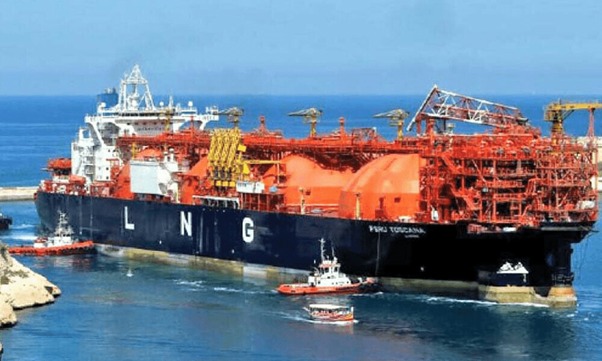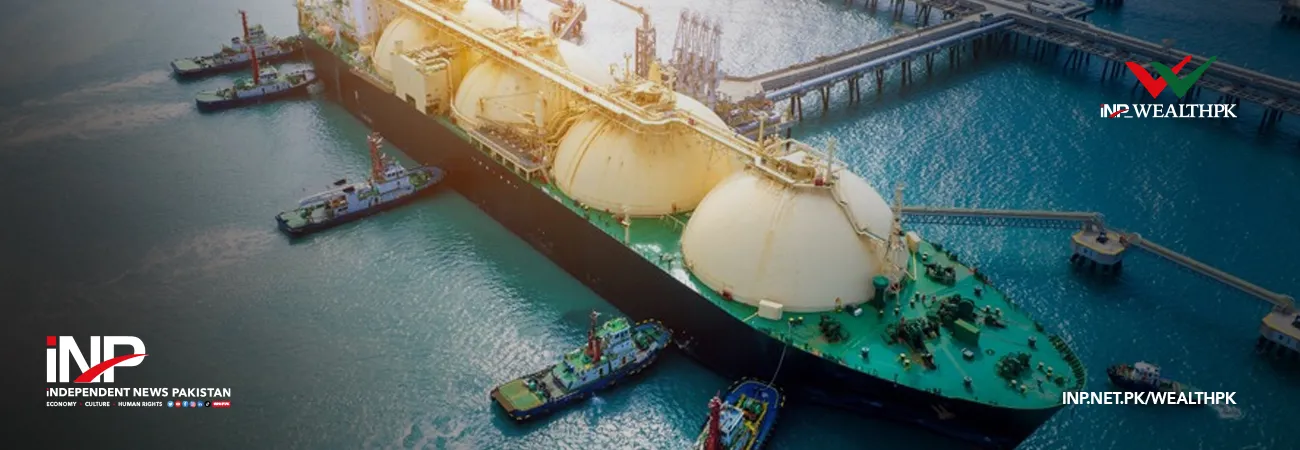آئی این پی ویلتھ پی کے
Ayesha Saba
Pakistan’s reliance on imported liquefied natural gas (LNG) continued to grow in fiscal year 2023-24 as the country faced another year of declining domestic gas production, rising energy demand, and binding long-term supply obligations. LNG imports increased by 13 percent year-on-year to 9.1 million tonnes of oil equivalent (Mtoe) in FY24, compensating for a 4 percent fall in indigenous gas output that left the national transmission network under strain.
The increase occurred despite tight fiscal conditions and foreign exchange shortages, highlighting the depth of Pakistan’s structural dependence on imported fuels. According to the Pakistan Energy Market Review 2025 by Renewables First, domestic natural gas production fell to an average of 3,117 million cubic feet per day (MMCFD) in FY24, continuing a downward trend that began in FY21.
Indigenous gas output has now dropped by 13 percent over the last five years as maturing fields in Sindh and Balochistan declined and few new discoveries were added to the system. Meanwhile, LNG imports reached 451,391 million cubic feet during the year, meeting 28 percent of national gas demand through regasification terminals at Port Qasim.
The report noted that two floating storage and regasification units Engro Elengy Terminal Limited (EETL) and Pakistan GasPort Consortium Limited (PGPCL) handled all incoming LNG volumes under unbundled long-term and spot contracts. Pakistan State Oil (PSO) imported LNG from Qatar under two long-term government-to-government sales agreements, while Pakistan LNG Limited (PLL) procured cargoes through spot and short-term tenders.
Together, the two companies maintained a total capacity of around 1,440 MMCFD, with average terminal tariffs of between 0.41 and 0.48 dollars per MMBTU. The report said that Brent-indexed contracts have made Pakistan’s LNG imports particularly vulnerable to global oil price volatility. Delivered ex-ship (DES) rates averaged between 11 and 13 dollars per MMBTU in FY24, while spot market fluctuations occasionally pushed prices above 15 dollars per MMBTU.
This exposure to external shocks inflated the overall import bill, keeping energy costs elevated despite lower global LNG benchmarks compared to the previous year. The review emphasized that these high costs were aggravated by the depreciation of the Pakistani rupee and the rising cost of freight and regasification. Pakistan adopted long-term LNG contracts in 2015 to address recurring fuel shortages, initially signing 15-year agreements with QatarGas (now Qatar Energy) and ENI of Italy.
Under these deals, PSO and PLL are contractually bound to import 120 cargoes per year, comprising 108 from Qatar and 12 from ENI. The take-or-pay nature of these contracts obliges Pakistan to pay for the cargoes even if domestic demand falls short. As demand from the power and industrial sectors weakened during FY24, the country was left with surplus volumes that could not be fully absorbed by its traditional consumers.
The review observed that to prevent contractual defaults and manage excess supply, imported LNG was increasingly diverted to domestic consumers through the networks of Sui Northern Gas Pipelines Limited (SNGPL) and Sui Southern Gas Company (SSGC). This diversion, while maintaining gas flow in the system, came at a heavy financial cost because regasified LNG is significantly more expensive than locally produced gas.
In September 2025, OGRA’s notified consumer rates stood at 12.01 dollars per MMBTU for SNGPL and 11.01 dollars per MMBTU for SSGC nearly three times higher than indigenous gas prices. The report warned that this pricing imbalance was eroding household affordability and increasing subsidy requirements for the government. Unlike conventional domestic gas tariffs, LNG is billed under a uniform rate structure rather than tiered slabs, making it particularly burdensome for low-consumption users.
The study projected that the continued diversion of LNG to households would heighten fiscal stress and undermine the financial stability of gas utilities. LNG imports have also added to Pakistan’s foreign exchange burden. The country spent about 3.9 billion dollars on LNG purchases in FY24, compared to 3.8 billion dollars a year earlier, despite lower international prices. The rise was primarily driven by higher import volumes and exchange rate depreciation.
The review indicated that Pakistan’s LNG dependence now forms a major component of the energy import bill, exposing the economy to global fuel price swings and supply chain disruptions. Experts warned that long-term LNG obligations could outpace actual consumption in the coming years if domestic gas shortages persist but overall demand remains muted due to high tariffs and weak industrial growth.
The study estimated that Pakistan could face a surplus of around 28 unused Qatar cargoes annually, with the cumulative surplus reaching 177 cargoes by 2030 unless contractual terms are restructured or domestic demand recovers. The review concluded that Pakistan’s increasing dependence on imported LNG reflects both a failure to expand domestic gas exploration and a growing mismatch between contracted supply and actual market absorption.
It cautioned that while LNG has played a critical role in maintaining short-term energy security, the resulting fiscal exposure, foreign exchange strain, and pricing disparity are unsustainable over the long run. According to the Pakistan Energy Market Review 2025 by Renewables First, Pakistan’s LNG strategy requires urgent rebalancing through demand forecasting, contract renegotiation, and accelerated investment in indigenous energy sources and renewables to ensure long-term energy affordability and stability.

Credit: INP-WealthPk




